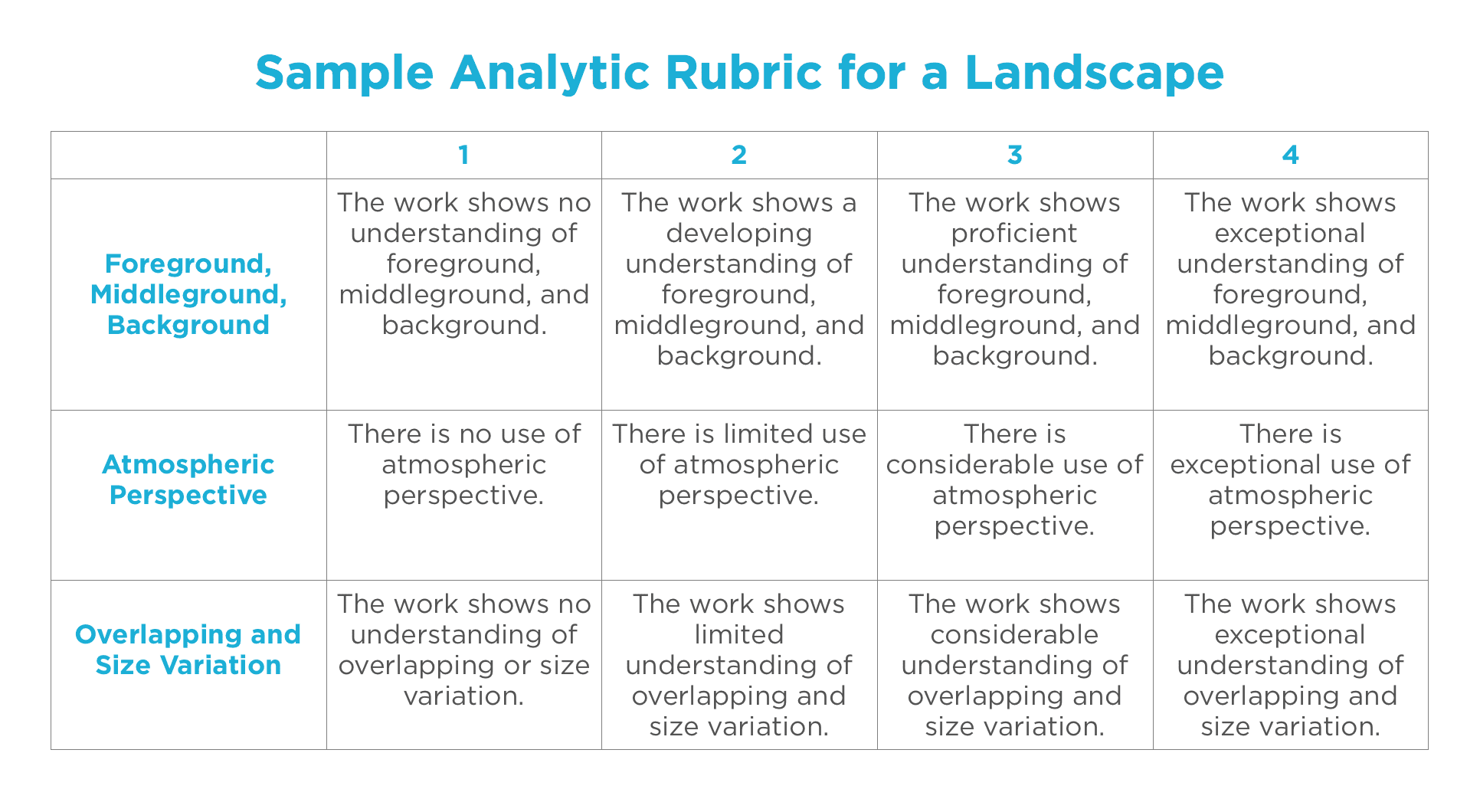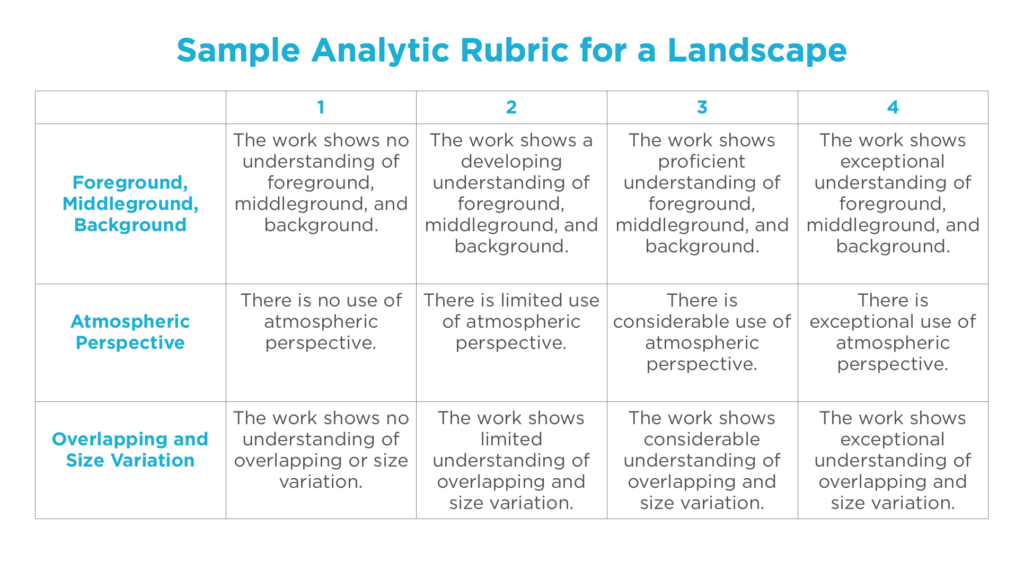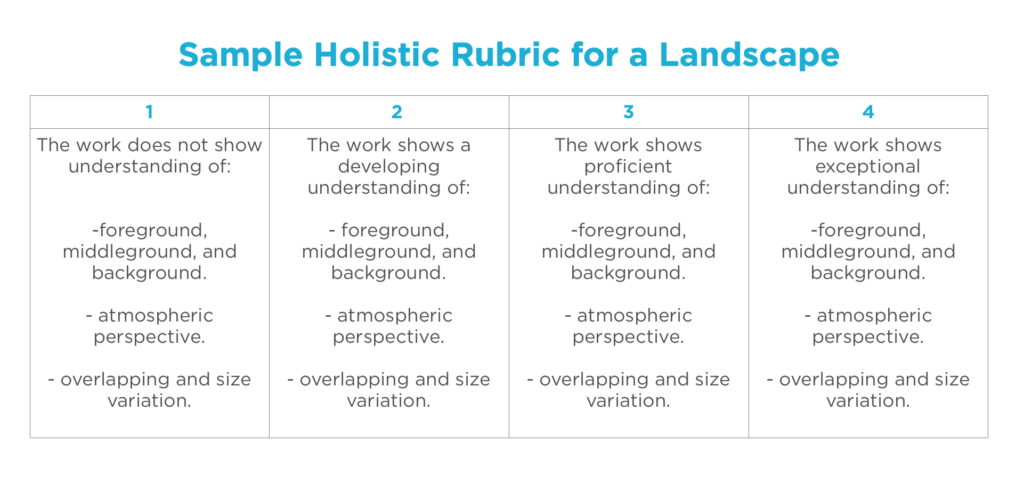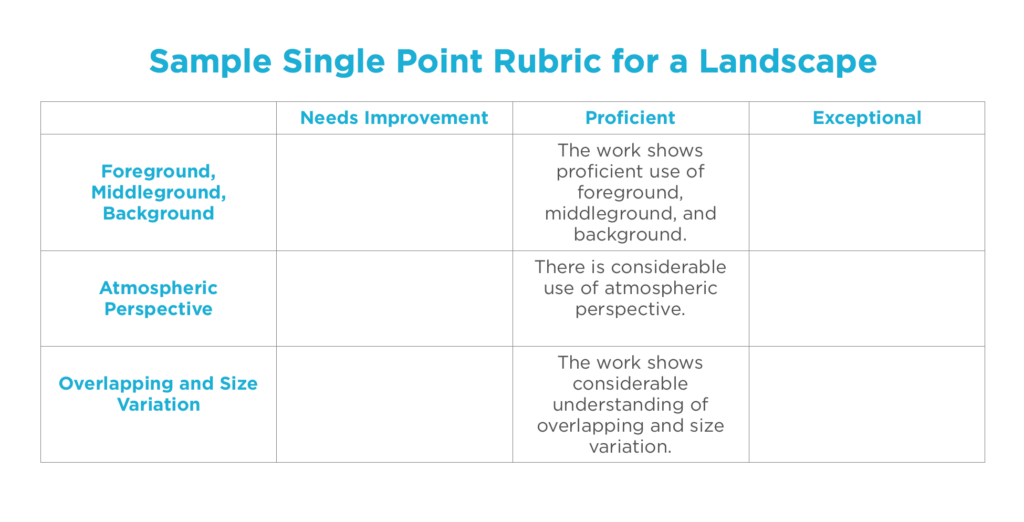Most art teachers use rubrics to assess students’ work. Rubrics are a great way to make sure students understand the expectations of the assignment. Because all the criteria are clearly defined, they make grading 100 still life artworks much easier. I use the term “easier” loosely here; we all know grading 100 artworks is never easy!
Choosing what type of rubric to use in your classes is an important choice. There are several different types of rubrics, and each has its own strengths and weaknesses. Spoiler alert, if you want to see my favorite type of rubric, jump right down to number 5!
First, let’s talk about how rubrics can describe the criteria. There are two main ways rubrics can do this, either in general terms or in more specific terms.

1. The General Rubric
This type of rubric defines characteristics of a successful artwork. It is “general,” meaning it does not define specific criteria for each project. Instead, it might define characteristics such as “technique” or “craftsmanship” you are looking for in each completed project.
The strengths of this type of rubric are you can share it with students to communicate a broad understanding of what makes “quality” work. It can be used over and over for different tasks such as sketchbook assignments and projects. It can also be used to help students assess their own work. Because it is generic, students will attain an understanding of your broad expectations through its continued use.
The weakness of this type of rubric is that it is very broad. It does not clearly define the criteria for each project.
2. The Task-Specific Rubric
A task-specific rubric is, as the name suggests, much more specific. It clearly defines the criteria for each assignment.
What is great about this rubric is that it makes expectations for each assignment very clear. Students can use this rubric to assess their success very easily. It also makes grading easier for teachers, because of its specificity.
The weakness of this type of rubric is that you need to make a new one for each assignment. This can be time-consuming.
Luckily, no matter what type of rubric you choose, there are always ways you can expedite your grading process. If you’re interested in learning more, Tim Bogatz shares some super helpful tips in the PRO Learning Pack, Expediting Your Grading Process. You’ll learn how to develop a more streamlined plan for all types of assessment. You can find this PRO Pack and more on assessment practices in PRO Learning.
Next, let’s talk about the structure of the rubric. Here, too, you have a few different choices.

3. The Analytic Rubric
An analytic rubric breaks down each aspect of the task being assessed. It assesses each criterion separately. For example, say you are teaching a lesson on landscapes to your students. You may want each student’s work to show:
- Foreground, Middleground, and Background
- Atmospheric Perspective
- Overlapping and Size Variation
In an analytic rubric, you would assess each of these criteria separately.
The great thing about these rubrics is they connect your instruction to the assessment very clearly. Students can use them to assess their own work easily. They can also be used for formative assessment. They can show growth when used to assess students again at the end of a unit. You can download an example below.
4. The Holistic Rubric
A holistic rubric is much simpler than an analytic rubric. Instead of breaking apart all the separate criteria, a holistic rubric assesses them all together.
So, if we use the above example of a still life, a holistic rubric would lump all of the criteria together (foreground, middleground, background, atmospheric perspective, overlapping, etc).
The advantage of a holistic rubric is that grading is much faster for the teacher. You only have to come up with a single score for each artwork you grade.
The limitation of this style of rubric is that it is not very useful to share with students. Because it does not break down the task into separate criteria, students would have a hard time using it to assess their work. In addition, it is difficult for students to see where they might improve if all the criteria are all clumped together in a single score. You can download a sample Holistic rubric below.
5. The Single-Point Rubric
In a single-point rubric, the expectations for the assignment are defined separately for a successful work, much like an analytic rubric. The difference is that criteria are only described for proficiency. Blank spaces are left for the teacher to write in feedback if the work falls above or below this point.
This is my favorite type of rubric. What I love about single-point rubrics is that they leave the teacher room to assess work individually. Instead of defining exactly what might make an artwork weaker or stronger, it leaves space for the teacher to give individual feedback for each student.
Yes, these take more work to fill out. I would not use a single-point rubric for every task. But for large projects, this is a great option. It gives the teacher the opportunity to give personalized feedback for each student. Once again, download an example below!
Rubrics are great tools to help communicate the expectations and assess students. If you choose the right rubric for the task, you will find it will help both you and your students be successful. For a comprehensive look at assessment in the art room, be sure to take a peek at the AOEU course Assessment in Art Education. You’ll leave class with a comprehensive toolkit of lesson plans and organization strategies.
What type of rubric do you use in your classes?
How do you give student feedback on your rubrics?
Magazine articles and podcasts are opinions of professional education contributors and do not necessarily represent the position of the Art of Education University (AOEU) or its academic offerings. Contributors use terms in the way they are most often talked about in the scope of their educational experiences.








